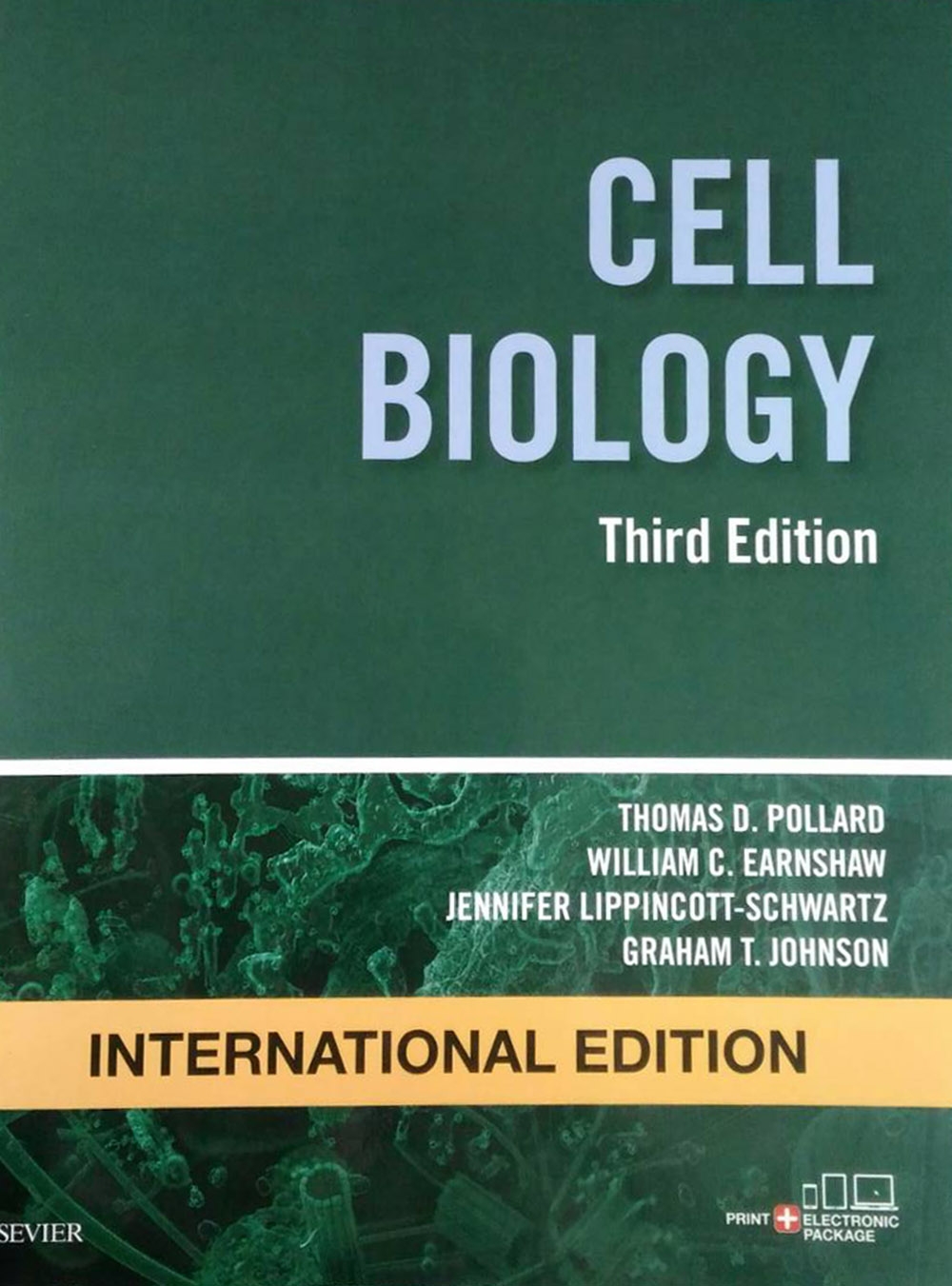The much-anticipated 3rd edition of ell Biology delivers omprehensive, clearly written, and richly illustrated ntent to today’s students, all in a user-friendly format. elevant to both research and clinical practice, this rich resource covers key principles of cellular function and uses them to explain how molecular defects lead to cellular dysfunction and cause human disease. oncise text and visually amazing graphics simplify complex information and help readers make the most of their study time.
Key Features
• Clearly written format incorporates rich illustrations, diagrams, and charts.
• Uses real examples to illustrate key cell biology concepts.
• Includes beneficial cell physiology coverage.
• Clinically oriented text relates cell biology to pathophysiology and medicine.
• Takes a mechanistic approach to molecular processes.
| FindBook |
|
有 1 項符合
Earnshaw William C. Ph.D.的圖書 |
 |
$ 2518 | Cell Biology (IE)
作者:Pollard Thomas D.M.D.、Earnshaw William C. Ph.D.、Lippincott-Schwartz Jennifer Ph.D.、Johnson Graham T. Ph.D. 出版社:九州 出版日期:2017-01-05 語言:英文 規格:精裝 / 882頁 / 22.4 x 28.2 x 3.6 cm / 普通級 / 單色印刷 / 3版  看圖書介紹 看圖書介紹
|
|
|
圖書介紹 - 資料來源:博客來 評分:
圖書名稱:Cell Biology (IE)
內容簡介
作者介紹
作者簡介
Thomas Pollard
Thomas Dean Pollard is a prominent educator, cell biologist and biophysicist whose research focuses on understanding cell motility through the study of actin filaments and myosin motors. He is Sterling Professor of Molecular, Cellular & Developmental Biology and a Professor of Cell Biology and Molecular Biophysics & Biochemistry at Yale University. He was Dean of Yale's Graduate School of Arts and Sciences from 2010 to 2014, and President of the Salk Institute for Biological Studies from 1996 to 2001. Pollard is very active in promoting scientific education and research primarily through two major societies, both of which he is a past President: the American Society for Cell Biology and the Biophysical Society
Affiliations and Expertise
Sterling Professor, Department of Molecular, Cellular, and Developmental Biology, Yale University, New Haven, CT
William Earnshaw
William Charles Earnshaw is Professor of Chromosome Dynamics at the University of Edinburgh where he has been a Wellcome Trust Principal Research Fellow since 1996. Earnshaw is an elected Fellow of the Royal Society since 2013 for his studies of mitotic chromosome structure and segregation. Before Edinburgh, he was Professor of Cell Biology and Anatomy at Johns Hopkins School of Medicine.
Affiliations and Expertise
Professor and Wellcome Trust Principal Research Fellow, Wellcome Trust Centre for Cell Biology, ICB, University of Edinburgh, Scotland, United Kingdom
Jennifer Lippincott-Schwartz
Jennifer Lippincott-Swartz is Group Leader at the Howard Hughes Medical Institute Janelia Research Campus. Her lab uses live cell imaging approaches to analyze the spatio-temporal behaviour and dynamic interactions of molecules in cells with a special focus on neurobiology. Before Janelia, Lippincott-Swartz was a primary investigator and chief of the Section on Organelle Biology in the Cell Biology and Metabolism Branch. Her work there included a collaboration with physicists Eric Betzig and Harald Hess (now group leaders at Janelia), who proposed a new function for the photoactivatable protein. The scientists used the protein to generate photoactivatable fluorophores, or dyes, which enabled them to illuminate different sets of molecules sequentially, creating a microscope image far more detailed than previously possible. The method, called super-resolution microscopy, garnered Betzig the 2014 Nobel Prize in Chemistry.
Affiliations and Expertise
Group Leader, Howard Hughes Medical Institute, Janelia Research Campus, Ashburn, Virginia, United States
Graham Johnson
Graham Johnson is a computational biologist and Certified Medical Illustrator (CMI) with approx. 20 years of professional experience. He is Director of the Animated Cell at the Allen Institute. Before the Allen Institute, Johnson’s lab in the California Institute for Quantitative Biosciences at the University of California, San Francisco worked to generate, simulate and visualize molecular models of cells. His lab’s Mesoscope project and his team at Allen Institute continue this mission by uniting biologists, programmers and artists to interoperate the computational tools of science and art.
Affiliations and Expertise
Director, Animated Cell, Allen Institute for Cell Biology, Seattle, Washington;, QB3 Faculty Fellow, University of California, San Francisco, San Francisco, California
Thomas Pollard
Thomas Dean Pollard is a prominent educator, cell biologist and biophysicist whose research focuses on understanding cell motility through the study of actin filaments and myosin motors. He is Sterling Professor of Molecular, Cellular & Developmental Biology and a Professor of Cell Biology and Molecular Biophysics & Biochemistry at Yale University. He was Dean of Yale's Graduate School of Arts and Sciences from 2010 to 2014, and President of the Salk Institute for Biological Studies from 1996 to 2001. Pollard is very active in promoting scientific education and research primarily through two major societies, both of which he is a past President: the American Society for Cell Biology and the Biophysical Society
Affiliations and Expertise
Sterling Professor, Department of Molecular, Cellular, and Developmental Biology, Yale University, New Haven, CT
William Earnshaw
William Charles Earnshaw is Professor of Chromosome Dynamics at the University of Edinburgh where he has been a Wellcome Trust Principal Research Fellow since 1996. Earnshaw is an elected Fellow of the Royal Society since 2013 for his studies of mitotic chromosome structure and segregation. Before Edinburgh, he was Professor of Cell Biology and Anatomy at Johns Hopkins School of Medicine.
Affiliations and Expertise
Professor and Wellcome Trust Principal Research Fellow, Wellcome Trust Centre for Cell Biology, ICB, University of Edinburgh, Scotland, United Kingdom
Jennifer Lippincott-Schwartz
Jennifer Lippincott-Swartz is Group Leader at the Howard Hughes Medical Institute Janelia Research Campus. Her lab uses live cell imaging approaches to analyze the spatio-temporal behaviour and dynamic interactions of molecules in cells with a special focus on neurobiology. Before Janelia, Lippincott-Swartz was a primary investigator and chief of the Section on Organelle Biology in the Cell Biology and Metabolism Branch. Her work there included a collaboration with physicists Eric Betzig and Harald Hess (now group leaders at Janelia), who proposed a new function for the photoactivatable protein. The scientists used the protein to generate photoactivatable fluorophores, or dyes, which enabled them to illuminate different sets of molecules sequentially, creating a microscope image far more detailed than previously possible. The method, called super-resolution microscopy, garnered Betzig the 2014 Nobel Prize in Chemistry.
Affiliations and Expertise
Group Leader, Howard Hughes Medical Institute, Janelia Research Campus, Ashburn, Virginia, United States
Graham Johnson
Graham Johnson is a computational biologist and Certified Medical Illustrator (CMI) with approx. 20 years of professional experience. He is Director of the Animated Cell at the Allen Institute. Before the Allen Institute, Johnson’s lab in the California Institute for Quantitative Biosciences at the University of California, San Francisco worked to generate, simulate and visualize molecular models of cells. His lab’s Mesoscope project and his team at Allen Institute continue this mission by uniting biologists, programmers and artists to interoperate the computational tools of science and art.
Affiliations and Expertise
Director, Animated Cell, Allen Institute for Cell Biology, Seattle, Washington;, QB3 Faculty Fellow, University of California, San Francisco, San Francisco, California
目錄
Section 1: Introduction to Cell Biology
1 Introduction to Cells
2 Evolution of Life on Earth
Section 2: Chemical and Physical Background
3 Molecules: Structures and Dynamics
4 Biophysical Principles
5 Macromolecular Assembly
6 Research Strategies
Section 3: Chromatin, Chromosomes, and the Cell Nucleus
7 Chromosome Organization
8 DNA Packaging in Chromatin and Chromosomes
9 Nuclear Structure and Dynamics
Section 4: Central Dogma: From Gene to Protein
10 Gene Expression
11 Eukaryotic RNA Processing
12 Protein Synthesis and Folding
Section 5: Membrane Structure and Function
13 Membrane Structure and Dynamics
14 Membrane Pumps
15 Membrane Carriers
16 Membrane Channels
17 Membrane Physiology
Section 6: Cellular Organelles and Membrane Trafficking
18 Posttranslational Targeting of Proteins
19 Mitochondria, Chloroplasts, Peroxisomes
20 Endoplasmic Reticulum
21 Secretory Membrane System and Golgi Apparatus
22 Endocytosis and the Endosomal Membrane
23 Processing and Degradation of Cellular Components
Section 7: Signaling Mechanisms
24 Plasma Membrane Receptors
25 Protein Hardware for Signaling
26 Second Messengers
27 Integration of Signals
Section 8: Cellular Adhesion and the Extracellular Matrix
28 Cells of the Extracellular Matrix and Immune System
29 Extracellular Matrix Molecules
30 Cellular Adhesion
31 Intercellular Junctions
32 Connective Tissues
Section 9: Cytoskeleton and Cellular Motility
33 Actin and Actin-Binding Proteins
34 Microtubules and Centrosomes
35 Intermediate Filaments
36 Motor Proteins
37 Intracellular Motility
38 Cellular Motility
39 Muscles
Section 10: Cell Cycle
40 Introduction to the Cell Cycle
41 G1 Phase and Regulation of Cell Proliferation
42 S Phase and DNA Replication
43 G2 Phase and Control of Entry into Mitosis
44 Mitosis and Cytokinesis
45 Meiosis
46 Programmed Cell Death
Glossary
Appendix
1 Introduction to Cells
2 Evolution of Life on Earth
Section 2: Chemical and Physical Background
3 Molecules: Structures and Dynamics
4 Biophysical Principles
5 Macromolecular Assembly
6 Research Strategies
Section 3: Chromatin, Chromosomes, and the Cell Nucleus
7 Chromosome Organization
8 DNA Packaging in Chromatin and Chromosomes
9 Nuclear Structure and Dynamics
Section 4: Central Dogma: From Gene to Protein
10 Gene Expression
11 Eukaryotic RNA Processing
12 Protein Synthesis and Folding
Section 5: Membrane Structure and Function
13 Membrane Structure and Dynamics
14 Membrane Pumps
15 Membrane Carriers
16 Membrane Channels
17 Membrane Physiology
Section 6: Cellular Organelles and Membrane Trafficking
18 Posttranslational Targeting of Proteins
19 Mitochondria, Chloroplasts, Peroxisomes
20 Endoplasmic Reticulum
21 Secretory Membrane System and Golgi Apparatus
22 Endocytosis and the Endosomal Membrane
23 Processing and Degradation of Cellular Components
Section 7: Signaling Mechanisms
24 Plasma Membrane Receptors
25 Protein Hardware for Signaling
26 Second Messengers
27 Integration of Signals
Section 8: Cellular Adhesion and the Extracellular Matrix
28 Cells of the Extracellular Matrix and Immune System
29 Extracellular Matrix Molecules
30 Cellular Adhesion
31 Intercellular Junctions
32 Connective Tissues
Section 9: Cytoskeleton and Cellular Motility
33 Actin and Actin-Binding Proteins
34 Microtubules and Centrosomes
35 Intermediate Filaments
36 Motor Proteins
37 Intracellular Motility
38 Cellular Motility
39 Muscles
Section 10: Cell Cycle
40 Introduction to the Cell Cycle
41 G1 Phase and Regulation of Cell Proliferation
42 S Phase and DNA Replication
43 G2 Phase and Control of Entry into Mitosis
44 Mitosis and Cytokinesis
45 Meiosis
46 Programmed Cell Death
Glossary
Appendix
|











